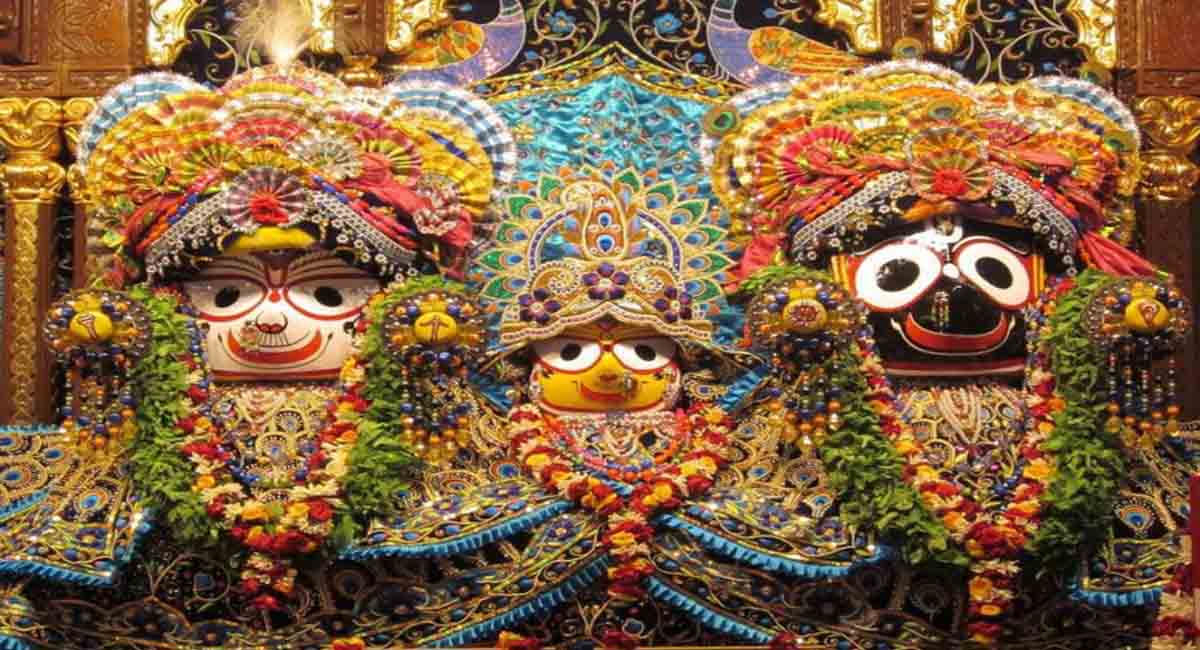Odisha, a state located in eastern India, is known for its rich cultural heritage, beautiful beaches, and ancient temples. The Jagannath Temple, located in the city of Puri, is one of the most famous temples in Odisha and is an important pilgrimage site for Hindus. We will take a comprehensive look at the Jagannath Temple and everything you need to know about it.
Shree Jagannath Temple Puri Darshan & Timings
| Rituals | Timings |
|---|---|
| Dwarpitha and Mangal Aarati | 5:00 am |
| Mailam | 6:00 am |
| Abakash | 6:00 am to 6:30 am |
| Mailam | 6:45 am |
| Sahanamela | 7:00 am to 8:00 am |
| Beshalagi | 8:00 am |
| Rosha Homa Surya Puja and Dwarapal | 8:00 am to 8:30 am |
| Gopala Ballava Puja | 9:00 am |
| Sakala Dhupa(Morning food offering)Mailam | 10:00 am |
| Mailam & Bhoga Mandap (2 to 3 times a day) | Madhyanha Dhoop Sandhya Dhoop |
| Madhyanha (Afternoon food offering) | 11:00 am to 1:00 pm |
| Madhyanha Pahudha | 1:00 pm to 1:30 pm |
| Sandhya Aarati | 5:30 pm |
| Sandhya Dhupa | 7:00 pm to 8:00 pm |
| Mailam and Chandana lagi | 8:30 pm |
| Badashringara Vesha | After Chanadana Lagi |
| BadaShringar Laga Bhoga | 9:30 pm to 10:30 pm |
| Khata Seja Lagi and Pahuda | 12:00 am (Midnight) |
Jagannath Temple History
The Jagannath Temple is a Hindu temple located in Puri, Odisha, India. It is dedicated to Lord Jagannath, an incarnation of Lord Vishnu, and is one of the Char Dham pilgrimage sites for Hindus.
The history of the Jagannath Temple dates back to the 12th century when it was built by King Anantavarman Chodaganga Deva. However, the temple has been rebuilt and renovated several times over the centuries due to various invasions and natural calamities.
According to legend, the idols of Lord Jagannath, Balabhadra, and Subhadra worshipped in the temple were originally carved by Lord Vishnu’s divine architect, Vishwakarma. Another legend says that the idols were made by King Indradyumna, who found the logs of the deities on the beach and had them carved into the present form.
The temple complex covers an area of over 400,000 square feet and consists of four main structures: the main temple, the Natamandira or the dancing hall, the Bhoga-mandapa or the offering hall, and the Mukti-mandapa or the hall of salvation.
The temple is famous for its annual Rath Yatra or chariot festival, where the idols of Lord Jagannath, Balabhadra, and Subhadra are taken out in a procession on three huge wooden chariots. The festival attracts millions of devotees from all over the world.
The Jagannath Temple is not just a place of worship but also a cultural and architectural marvel. Its history, legends, and traditions continue to fascinate people to this day.
Jagannath Temple Architecture
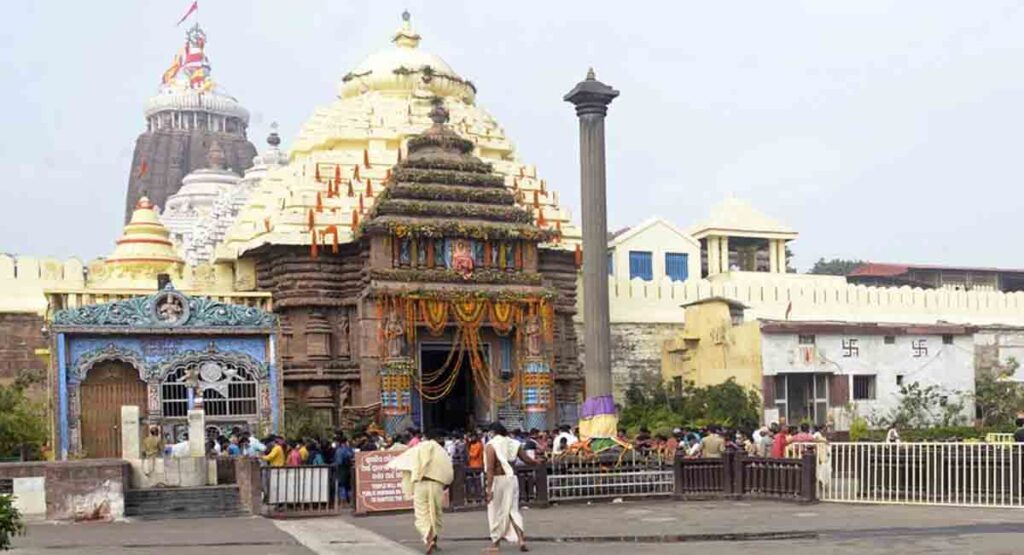
The Jagannath Temple in Puri, Odisha, India is renowned for its unique architecture. The temple complex covers an area of over 400,000 square feet and consists of four main structures: the main temple, the Natamandira or the dancing hall, the Bhoga-mandapa or the offering hall, and the Mukti-mandapa or the hall of salvation.
The main temple or the ‘Deul’ is a towering structure of 65 metres high, built in the Kalinga style of architecture. The temple is made of stone and is divided into four sections, namely, the Garbhagriha or the sanctum sanctorum, the Yajnashala or the hall of sacrifices, the Bhogamandapa or the offering hall, and the Ananda Bazar or the marketplace.
The temple is famous for its elaborate carvings and intricate sculptures, depicting scenes from the Hindu epics like the Ramayana and the Mahabharata. The temple is also adorned with beautiful stone sculptures of various deities, animals, and mythical creatures.
The Natamandira or the dancing hall is a spacious hall where the idols of Lord Jagannath, Balabhadra, and Subhadra are kept during the annual Rath Yatra festival. The hall is supported by 56 pillars, each intricately carved with images of dancers, musicians, and other mythological figures.
The Bhoga-mandapa or the offering hall is where the food offerings are made to the deities. The hall is supported by 32 pillars, each depicting the 32 forms of Lord Vishnu.
The Mukti-mandapa or the hall of salvation is a large hall where the devotees gather to hear the religious discourses and lectures. The hall is supported by 16 pillars, each depicting the 16 forms of Lord Shiva.
Rath Yatra Puri
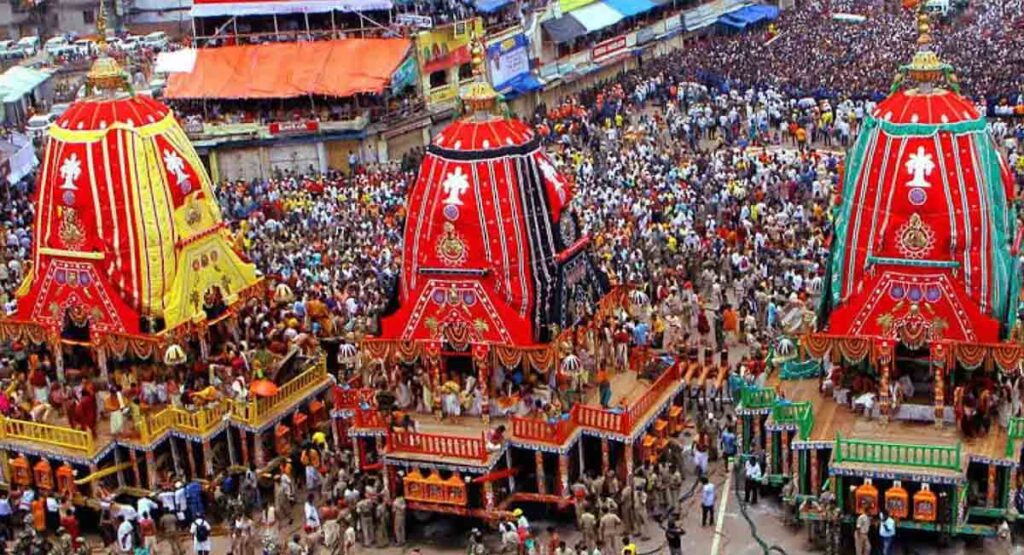
Rath Yatra, also known as the chariot festival, is one of the most significant and celebrated festivals in India, particularly in the state of Odisha. It is held annually in the city of Puri, at the Jagannath Temple, in the months of June or July.
During Rath Yatra, the idols of Lord Jagannath, Balabhadra, and Subhadra are taken out in a grand procession on three huge wooden chariots. The chariots are beautifully decorated with bright colors, intricate designs, and adorned with flowers and other ornaments.
The chariots are constructed every year using special types of wood by skilled artisans, according to strict religious and architectural guidelines. The chariot of Lord Jagannath is the largest, measuring about 45 feet high, while the chariots of Balabhadra and Subhadra are smaller.
The idols are placed on the chariots and pulled by devotees using long ropes, amidst the sound of conch shells, bells, and other musical instruments. The procession starts from the Jagannath Temple and covers a distance of about three kilometers before returning to the temple.
The procession is attended by millions of devotees from all over the world, who gather to witness the grandeur of the event and seek blessings from Lord Jagannath. It is believed that pulling the chariots during Rath Yatra is a sacred act that brings good luck and prosperity.
Rath Yatra is not only a religious festival but also a cultural and social event, as it brings people from different walks of life together to celebrate the rich cultural heritage of Odisha. The festival is a symbol of unity and brotherhood, and its spirit of love, devotion, and joy transcends all boundaries of caste, creed, and religion.
Jagannath Temple Rituals
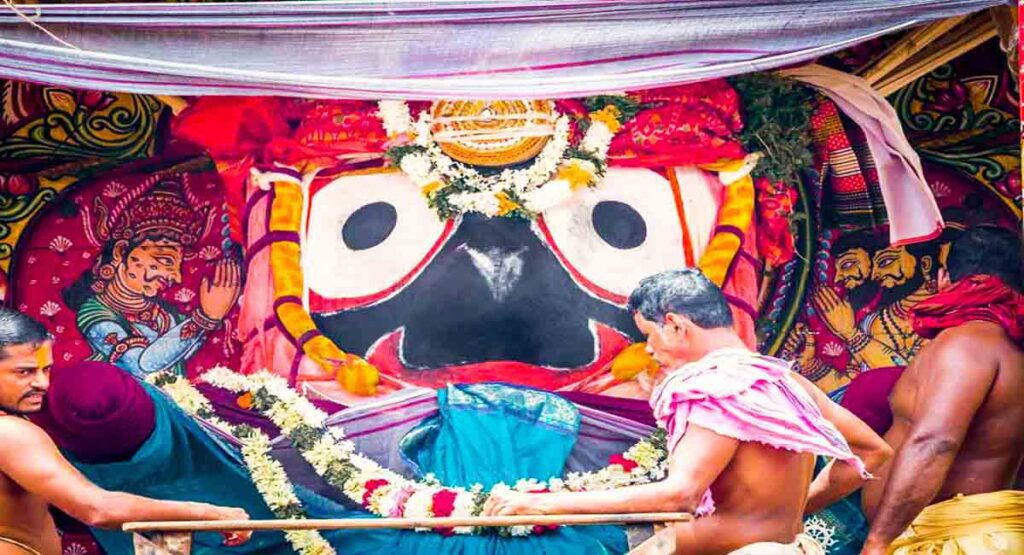
The Jagannath Temple in Puri, Odisha, India is a holy shrine dedicated to Lord Jagannath, an incarnation of Lord Vishnu. The temple is renowned for its elaborate rituals and ceremonies, which are performed every day with great devotion and reverence.
One of the most important rituals at the temple is the ‘Dhupa’ or the morning offering of food to the deities. The food offerings, known as ‘Mahaprasad,’ are prepared in the temple’s kitchen using traditional methods and ingredients. The Mahaprasad is considered sacred and is believed to have the power to cure diseases and bless devotees with good health and prosperity.
Another important ritual is the ‘Sandhya Dhupa’ or the evening offering of food to the deities. The Mahaprasad is offered again in the evening, along with other items such as fruits, sweets, and betel leaves.
The ‘Badasinghara Besha’ or the morning adornment ceremony is a unique ritual where the idols are decorated with 108 gold ornaments. The ceremony is performed every day, except during the monsoon season.
The ‘Chandana Lagi’ or the application of sandalwood paste on the deities is another important ritual performed at the temple. The paste is believed to have a cooling effect on the deities and is applied during the summer months.
The ‘Dola Yatra’ or the swing festival is a ritual where the idols of Lord Jagannath, Balabhadra, and Subhadra are placed on swings and swung gently by the devotees.
The ‘Nabajoubana Darshan’ or the first glimpse of the deities after their annual bathing ceremony is a highly anticipated event. During this ritual, the idols are adorned with new clothes and ornaments and displayed to the devotees for their darshan.
Overall, the rituals at the Jagannath Temple are a reflection of the rich cultural heritage of Odisha and the deep devotion of the people towards Lord Jagannath. The rituals are performed with great devotion and discipline and attract millions of devotees from all over the world every year.
Jagannath Temple Timings
The Jagannath Temple in Puri, Odisha, India is open for darshan (worship) by devotees throughout the year, except during certain festivals and special occasions. The temple has different timings for different rituals and ceremonies, as well as for general darshan.
The temple opens early in the morning, around 5:00 AM, and the first ritual of the day, known as the ‘Mangala Aarti,’ is performed at 6:00 AM. This is followed by the morning offering of Mahaprasad to the deities, which is offered at around 7:00 AM.
After the morning rituals are completed, the temple is open for general darshan from around 8:00 AM to 1:00 PM. During this time, devotees can offer their prayers and seek blessings from the deities.
In the afternoon, the temple remains closed for a few hours, and the evening rituals begin at around 4:00 PM with the ‘Sandhya Aarti.’ The evening offering of Mahaprasad and other items is made to the deities at around 7:00 PM.
After the evening rituals are completed, the temple is again open for general darshan from around 8:00 PM to 11:00 PM. The temple timings may vary slightly during festivals and special occasions, and it is advisable to check with the temple authorities before planning a visit.
The Jagannath Temple is a highly revered and sacred shrine, and devotees from all over the world visit it to seek blessings and offer their prayers to Lord Jagannath, Balabhadra, and Subhadra.
Jagannath Temple Prasad
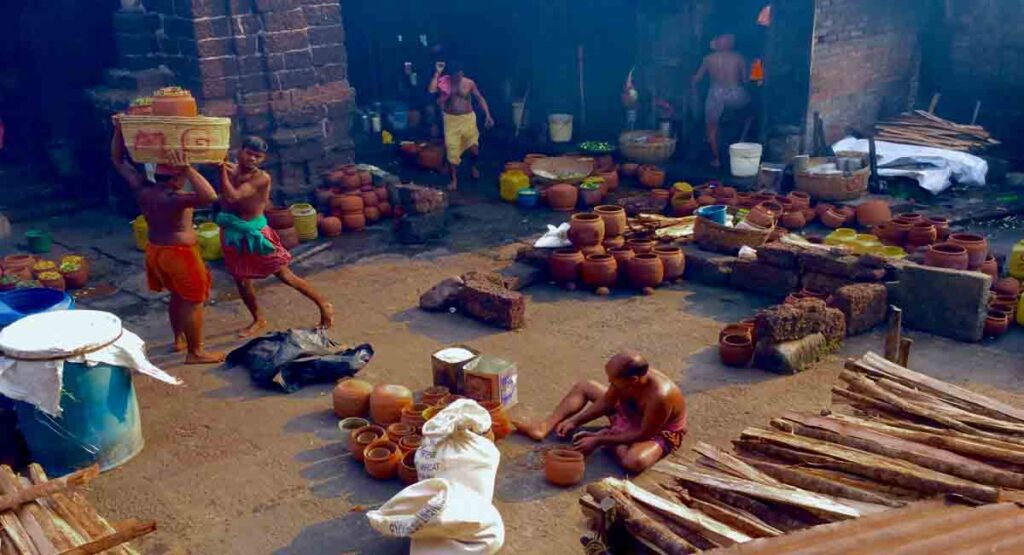
The Jagannath Temple in Puri, Odisha, India is renowned for its famous Mahaprasad, which is considered sacred and is believed to have the power to cure diseases and bless devotees with good health and prosperity. The Mahaprasad is a special type of prasad (offering) made from different food items, which is offered to Lord Jagannath, Balabhadra, and Subhadra every day.
The Mahaprasad is prepared in the temple’s kitchen, which is one of the largest kitchens in the world. The kitchen, also known as the ‘Ananda Bazaar,’ has a long tradition of preparing the Mahaprasad using traditional methods and ingredients. The food items used in the Mahaprasad include rice, dal, vegetables, and sweets, among others.
The Mahaprasad is distributed among the devotees after it is offered to the deities. The distribution is done in different forms, including ‘Anna Bhoga,’ which is a plate of rice and dal, and ‘Abhada Bhoga,’ which is a plate of different food items.
The Mahaprasad is believed to be very special and is considered to be a blessing from Lord Jagannath. It is said that eating the Mahaprasad with devotion and sincerity can bring good health, wealth, and prosperity to the devotees.
Overall, the Mahaprasad is an important aspect of the Jagannath Temple and is an integral part of the temple’s culture and tradition. The Mahaprasad is not only a form of prasad but also represents the hospitality and generosity of Lord Jagannath towards his devotees.
Jagannath Temple Facts
Here are some interesting facts about the Jagannath Temple in Puri, Odisha, India:
- The Jagannath Temple is one of the most revered and sacred Hindu temples in India and is considered one of the Char Dham pilgrimage sites.
- The temple is believed to have been built in the 12th century by the Ganga dynasty king, Anantavarman Chodaganga Deva.
- The temple is dedicated to Lord Jagannath, an incarnation of Lord Vishnu, and his siblings Balabhadra and Subhadra.
- The temple’s main tower, known as the ‘Shikhara,’ is around 214 feet tall and is visible from a distance.
- The temple has four main gates, which are known as the ‘Singhadwara,’ the ‘Ashwadwara,’ the ‘Hathidwara,’ and the ‘Vyaghradwara.’
- The temple’s kitchen, known as the ‘Ananda Bazaar,’ is one of the largest kitchens in the world and can feed up to 100,000 people on a daily basis.
- The famous Rath Yatra, or the ‘Chariot Festival,’ is celebrated every year in the month of June or July, during which the deities are taken out in a procession on chariots.
- The temple has a unique tradition of offering Mahaprasad, which is a special type of prasad made from different food items, which is believed to be sacred and has the power to cure diseases and bless devotees with good health and prosperity.
- The temple is also known for its exquisite architecture, which features intricate carvings and sculptures depicting scenes from Hindu mythology.
- The temple attracts millions of devotees from all over the world every year, who come to seek blessings and offer their prayers to Lord Jagannath, Balabhadra, and Subhadra.
Jagannath Temple Darshan

The Jagannath Temple in Puri, Odisha, India is a revered Hindu temple and is visited by millions of devotees every year. Darshan, which means to have a glimpse of the deity, is an important aspect of the temple visit for many devotees.
Here is some information on Jagannath Temple Darshan
- The temple is open for darshan from early morning till late evening, with different timings for different rituals and ceremonies.
- There are different queues for men and women, and devotees are required to follow the dress code and other rules and regulations while entering the temple.
- The darshan timings and queues may vary depending on the season and the rush of devotees.
- The darshan of Lord Jagannath, Balabhadra, and Subhadra can be obtained from the main sanctum, where the deities are placed on a raised platform.
- Devotees can also have a darshan of the deities from the outside of the sanctum, through the windows or doors.
- The darshan of the deities is considered very auspicious, and many devotees offer their prayers and seek blessings during their darshan.
- The temple authorities have also introduced online darshan facilities for devotees, which enables them to have a virtual darshan of the deities from their homes or anywhere in the world.
The Jagannath Temple darshan is an important aspect of the temple visit for many devotees, and it offers them an opportunity to seek the blessings of Lord Jagannath, Balabhadra, and Subhadra.
Jagannath Temple Festival
The Jagannath Temple in Puri, Odisha, India is known for its vibrant and colorful festivals that are celebrated throughout the year. The festivals are an important aspect of the temple’s culture and traditions and attract a large number of devotees from all over the world.
Here are some of the major festivals celebrated at the Jagannath Temple:
- Rath Yatra: The Rath Yatra or the Chariot Festival is one of the most important festivals celebrated at the Jagannath Temple. It is celebrated in the month of June or July and involves the procession of the deities on chariots, pulled by devotees. The festival is celebrated with great enthusiasm and attracts millions of devotees.
- Chandan Yatra: The Chandan Yatra is a 21-day festival that is celebrated in the month of May or June. The festival involves the bathing of the deities with sandalwood paste, and they are taken on a procession in a decorated boat in a nearby tank.
- Snana Yatra: The Snana Yatra or the Bathing Festival is celebrated in the month of June and involves the bathing of the deities with 108 pots of water. The festival is believed to cure diseases and purify the souls of the devotees.
- Anavasara: The Anavasara is a 15-day festival that is celebrated after the Snana Yatra, during which the deities are believed to be in a state of illness and are kept away from public view.
- Nava Kalebara: The Nava Kalebara is a rare and unique festival that is celebrated once in 12 or 19 years, during which the old wooden idols of the deities are replaced with new ones.
- Dola Yatra: The Dola Yatra or the Swing Festival is celebrated in the month of March or April and involves the swinging of the deities on decorated swings.
- Ratha Anukula: The Ratha Anukula is a 10-day festival that is celebrated in the month of December or January and involves the deities being placed in miniature chariots.
These festivals are a great opportunity for devotees to seek the blessings of Lord Jagannath, Balabhadra, and Subhadra and witness the rich culture and traditions of the Jagannath Temple.
Jagannath Temple Legends
The Jagannath Temple in Puri, Odisha, India is steeped in legends and mythology that are an important aspect of its history and culture. Here are some of the popular legends associated with the temple:
- Legend of Lord Jagannath’s appearance: According to one legend, Lord Jagannath appeared in a dream to King Indradyumna, who then commissioned the construction of the temple to enshrine the deity. Another legend states that Lord Vishnu appeared in the form of a boar to rescue the earth from the demon Hiranyaksha, and the Jagannath Temple was built at the spot where Lord Vishnu emerged from the earth.
- Legend of Lord Jagannath’s wooden idols: It is believed that the wooden idols of Lord Jagannath, Balabhadra, and Subhadra were carved by Lord Vishwakarma, the architect of the gods. Another legend states that King Indradyumna found a log of wood on the beach and had it carved into the idols by skilled craftsmen.
- Legend of Lord Jagannath’s food: It is believed that Lord Jagannath is very fond of food, and every day, he is offered a variety of dishes, including the famous Mahaprasad. According to legend, the Mahaprasad is prepared by Lord Jagannath’s consort, Goddess Mahalakshmi, and it is believed to be blessed with the deity’s divine touch.
- Legend of Lord Jagannath’s marriage: According to one legend, Lord Jagannath’s consort, Goddess Subhadra, was in love with a mortal named Arjuna. Lord Jagannath agreed to their marriage and even helped Arjuna win a battle so that he could marry Subhadra.
- Legend of Lord Jagannath’s Rath Yatra: It is believed that Lord Jagannath, Balabhadra, and Subhadra go on a journey to their aunt’s house during the Rath Yatra, and this journey is believed to symbolize the journey of the soul towards salvation.
These legends are an important part of the Jagannath Temple’s history and culture, and they continue to inspire millions of devotees to seek the blessings of Lord Jagannath, Balabhadra, and Subhadra.
Jagannath Temple Significance

The Jagannath Temple in Puri, Odisha, India is considered one of the most important Hindu pilgrimage sites, and it holds great significance for devotees of Lord Jagannath, Balabhadra, and Subhadra. Here are some of the reasons why the temple is so significant:
- Religious significance: The Jagannath Temple is dedicated to Lord Jagannath, who is considered to be an incarnation of Lord Vishnu, one of the most important deities in Hinduism. The temple is also home to the idols of Lord Balabhadra and Goddess Subhadra, who are considered to be the siblings of Lord Jagannath.
- Cultural significance: The Jagannath Temple is an important cultural landmark in India, and it is known for its unique style of architecture, which is a blend of Kalinga and Dravidian styles. The temple is also famous for its Rath Yatra, which is a grand procession that takes the idols of Lord Jagannath, Balabhadra, and Subhadra out of the temple and into the streets of Puri.
- Social significance: The Jagannath Temple is known for its unique traditions and customs, which are deeply rooted in the local culture. The temple provides employment to thousands of people, including priests, cooks, and craftsmen, and it also serves as a hub for social and cultural activities.
- Spiritual significance: The Jagannath Temple is believed to be a powerful source of spiritual energy, and millions of devotees visit the temple every year to seek the blessings of Lord Jagannath, Balabhadra, and Subhadra. It is believed that a visit to the temple can help one attain moksha or liberation from the cycle of birth and death.
The Jagannath Temple is an important symbol of Hinduism, and it holds great significance for devotees all over the world. The temple is a testament to the rich cultural heritage of India, and it continues to inspire millions of people with its spiritual and cultural significance.
Jagannath Temple Dress Code
The Jagannath Temple in Puri, Odisha, India has a strict dress code for visitors. Here are some important points to keep in mind:
- Modest clothing: Visitors are required to dress modestly and avoid wearing clothes that are too revealing or inappropriate. Shorts, skirts, and sleeveless tops are not allowed.
- Traditional attire: Visitors are encouraged to wear traditional Indian attire, such as saris, dhotis, and kurta-pajamas.
- Headgear: Visitors are required to cover their heads with a dupatta, shawl, or any other suitable headgear. This is considered a sign of respect when entering the temple.
- Footwear: Visitors are not allowed to wear shoes or sandals inside the temple premises. They can either leave their footwear outside or carry them in a bag.
- Cleanliness: Visitors are expected to maintain cleanliness and hygiene while visiting the temple. Bathing and wearing clean clothes before entering the temple is considered a good practice.
- No leather items: The use of leather items, such as belts, wallets, and bags, is strictly prohibited inside the temple premises.
Visitors who do not comply with the dress code may be denied entry into the temple. It is always a good idea to check the temple’s dress code guidelines before visiting to avoid any inconvenience.
Jagannath Temple Visiting Hours
The Jagannath Temple in Puri, Odisha, India has different visiting hours for different times of the year. Here are some important points to keep in mind:
- Summer season: During the summer season, which typically lasts from April to June, the temple is open from 5:00 AM to 10:00 PM.
- Monsoon season: During the monsoon season, which typically lasts from July to September, the temple is open from 5:00 AM to 9:00 PM.
- Winter season: During the winter season, which typically lasts from October to March, the temple is open from 6:00 AM to 8:00 PM.
Note that the temple is closed for about two hours in the afternoon for “bhoga” (food offering) to the deities. The exact timing of the bhoga may vary depending on the day and season.
It is always a good idea to check the temple’s website or local tourist information centers for the latest information on visiting hours before planning your visit. Also, during certain festivals or special occasions, the visiting hours may be extended, so it is best to check in advance to avoid any inconvenience.
How to Reach Jagannath Temple

The Jagannath Temple is located in Puri, Odisha, India and is easily accessible by different modes of transportation. Here are some ways to reach the temple:
- By Air: The nearest airport is the Biju Patnaik International Airport in Bhubaneswar, which is about 60 km away from Puri. From there, you can hire a taxi or take a bus to reach the temple.
- By Train: Puri has a railway station that is well-connected to different parts of the country. The station is located about 3 km away from the temple, and you can take a taxi, auto-rickshaw, or cycle-rickshaw to reach the temple.
- By Road: Puri is well-connected to different cities and towns in Odisha and other neighboring states. You can take a bus or hire a taxi to reach the temple. The National Highway 16 (previously known as NH-5) passes through Puri, making it easily accessible by road.
- Local transportation: Once you reach Puri, you can hire a taxi, auto-rickshaw, or cycle-rickshaw to reach the temple. There are also buses and other public transportation options available.
It is always a good idea to plan your travel in advance and check the latest information on transportation options before your visit to avoid any inconvenience.
Jagannath Temple Puri Video
Frequently Asked Questions
What is special about Puri Jagannath temple?
The Jagannath Temple in Puri is one of the most revered temples in India and is famous for its annual Rath Yatra festival. The temple is dedicated to Lord Jagannath, an incarnation of Lord Vishnu, and is known for its unique architecture and intricate carvings. The temple is also believed to be one of the four most sacred places (Char Dham) for Hindus.
What happens every 12 years in Jagannath Puri?
The Nabakalebara festival happens every 12 years in Jagannath Puri, where the idols of Lord Jagannath, Balabhadra, and Subhadra are replaced with new ones. This is a significant event for devotees, and millions of people from all over the world come to witness it.
What is the best time to visit Jagannath Puri?
The best time to visit Jagannath Puri is between October and March, during the winter season when the weather is pleasant. However, if you want to witness the famous Rath Yatra festival, which usually happens in June or July, you should plan your visit accordingly.
Why Jagannath Temple closed for 14 days?
The Jagannath Temple in Puri is closed for about 14 days every year during the Anasara period when the deities are believed to fall ill after the Rath Yatra festival. The deities are kept in isolation and are treated with herbal medicine, and during this time, no public viewing or rituals are allowed.
What is the entry fee of Puri Jagannath Temple?
There is no entry fee to visit the Jagannath Temple in Puri. However, there are some charges for different services like the special darshan or prasad offerings. It is always a good idea to check the temple’s website or local tourist information centers for the latest information on fees and charges before planning your visit.

